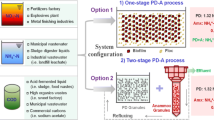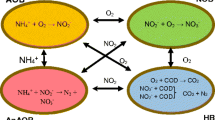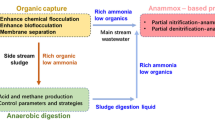Abstract
Inefficient nitrogen removal during wastewater treatment is undesirable as it affects human health adversely and causes eutrophication triggered oxygen depletion in the receiving water bodies. The main conversion pathway (aerobic autotrophic nitrification followed by anoxic heterotrophic denitrification) in traditional aerobic treatment systems necessitates an additional anoxic unit process to meet the nitrogen discharge standards resulting in cost escalation and biomass acclimatization problems. The discovery of alternative nitrogen conversion routes like sulphur oxidizing autotrophic denitrification (SOAD), heterotrophic nitrification aerobic denitrification (HNAD), and ANAMMOX processes have opened unforeseen avenues that may contribute significantly to total nitrogen removal under specific environmental conditions. SOAD can carry out denitrification in carbon-limiting conditions utilizing reduced sulphur compounds as source of electrons and energy, with a concomitant reduction in the total greenhouse gas (N2O) emission. HNAD couples the reducing power generated during heterotrophic nitrification to aerobic denitrification in a single reactor and can convert nitrate nitrogen efficiently at low DO levels. ANAMMOX bacteria can anaerobically convert ammonium ion to nitrogen directly utilizing nitrite—generated either by nitritation or by coupled nitrification—partial denitrification. Suitable process controls allow generation of anoxic conditions in biofilms or fluidized systems of many existing aerobic technologies facilitating maintenance of ANAMMOX bacteria. These systems can potentially become energy self-sustainable by diverting the organic matter saved through reduced consumption in ANAMMOX process to methane generation. This chapter discusses some recent developments in the microbiology of such specialized bacteria and identifies their possible role in enhancing the performance of nitrogen removal.
Access this chapter
Tax calculation will be finalised at checkout
Purchases are for personal use only
Similar content being viewed by others
References
Bednarek A, Szklarek S, Zalewski M (2014) Nitrogen pollution removal from areas of intensive farming—comparison of various denitrification biotechnologies. Ecohydrol Hydrobiol 14(2):132–141
Blackburne R, Yuan Z, Keller J (2008) Partial nitrification to nitrite using low dissolved oxygen concentration as the main selection factor. Biodegradation 19(2):303–312
Cao Y, Kwok BH, Yong WH, Chua SC, Wah YL, Ghani YABD (2013) Mainstream partial nitritation-ANAMMOX nitrogen removal in the largest full-scale activated sludge process in Singapore: process analysis. In: Proc. WEF/IWA nutrient removal and recovery conference. Water Environment Federation, Richmond, VA, pp 28–31
Cao Y, Hong KB, Zhou Y, Liu Y, Jianzhong H, Chye CS, Long WY, Ghani Y (2015) The mainstream partial nitritation/ANAMMOX nitrogen removal process in the largest water reclamation plant in Singapore. J Bei**g Univ Technol 41(10):1441
Cao Y, van Loosdrecht MC, Daigger GT (2017) Mainstream partial nitritation-ANAMMOX in municipal wastewater treatment: status, bottlenecks, and further studies. Appl Microbiol Biotechnol 101(4):1365–1383
Cardoso RB, Sierra-Alvarez R, Rowlette P, Flores ER, Gómez J, Field JA (2006) Sulfide oxidation under chemolithoautotrophic denitrifying conditions. Biotechnol Bioeng 95(6):1148–1157
Chen Q, Ni J (2012) Ammonium removal by Agrobacterium sp. LAD9 capable of heterotrophic nitrification-aerobic denitrification. J Biosci Bioeng 113(5):619–623
Chen M, Wang W, Feng Y, Zhu X, Zhou H, Tan Z, Li X (2014) Impact resistance of different factors on ammonia removal by heterotrophic nitrification-aerobic denitrification bacterium Aeromonas sp. HN-02. Bioresour Technol 167:456–461
Cui YX, Biswal BK, Guo G, Deng YF, Huang H, Chen GH, Wu D (2019) Biological nitrogen removal from wastewater using sulphur-driven autotrophic denitrification. Appl Microbiol Biotechnol 103(15):6023–6039
Damsté JSS, Strous M, Rijpstra WIC, Hopmans EC, Geenevasen JA, van Duin AC, Van Niftrik LA, Jetten MS (2002) Linearly concatenated cyclobutane lipids form a dense bacterial membrane. Nature 419(6908):708–712
Du R, Peng Y, Ji J, Shi L, Gao R, Li X (2019) Partial denitrification providing nitrite: opportunities of extending application for ANAMMOX. Environ int 131:105001
Erguder TH, Boon N, Wittebolle L, Marzorati M, Verstraete W (2009) Environmental factors sha** the ecological niches of ammonia-oxidizing archaea. FEMS Microbiol Rev 33(5):855–869
Erisman JW, Galloway JN, Seitzinger S, Bleeker A, Dise NB, Petrescu AR, Leach AM, de Vries W (2013) Consequences of human modification of the global nitrogen cycle. Philos Trans R Soc B Biol Sci 368(1621):20130116
Fajardo C, Mora M, Fernández I, Mosquera-Corral A, Campos JL, Méndez R (2014) Cross effect of temperature, pH and free ammonia on autotrophic denitrification process with sulphide as electron donor. Chemosphere 97:10–15
Francis CA, Beman JM, Kuypers MM (2007) New processes and players in the nitrogen cycle: the microbial ecology of anaerobic and archaeal ammonia oxidation. ISME J 1(1):19–27
Gadekar S, Nemati M, Hill GA (2006) Batch and continuous biooxidation of sulphide by Thiomicrospira sp. CVO: reaction kinetics and stoichiometry. Water Res 40(12):2436–2446
Ghafari S, Hasan M, Aroua MK (2008) Bio-electrochemical removal of nitrate from water and wastewater—a review. Bioresour Technol 99(10):3965–3974
Goldstein DJ, Casana JG (1982) Municipal wastewater reuse in power plant cooling systems. In: Water reuse. Ann Arbor Science, Ann Arbor, MI, pp 431–464. 6 fig, 10 tab, 53 ref
Gu JD, Qiu W, Koenig A, Fan Y (2004) Removal of high NO3- concentrations in saline water through autotrophic denitrification by the bacterium Thiobacillusdenitrificans strain MP. Water Sci Technol 49(5–6):105–112
Gu J, Yang Q, Liu Y (2018) A novel strategy towards sustainable and stable nitritation-denitritation in an AB process for mainstream municipal wastewater treatment. Chemosphere 193:921–927
Guo G, Wang Y, Hao T, Wu D, Chen GH (2018) Enzymatic nitrous oxide emissions from wastewater treatment. Front Environ Sci Eng 12(1):10
Gupta AB, Gupta SK (1999) Simultaneous carbon and nitrogen removal in a mixed culture aerobic RBC biofilm. Water Res 33(2):555–561
Gupta SK, Gupta RC, Seth AK, Gupta AB, Bassin JK, Gupta A (1999a) Adaptation of cytochrome-b5 reductase activity and methaemoglobinaemia in areas with a high nitrate concentration in drinking-water. Bull World Health Organ 77(9):749
Gupta SK, Gupta RC, Seth AK, Gupta AB, Bassin JK, Gupta DK, Sharma S (1999b) Epidemiological evaluation of recurrent stomatitis, nitrates in drinking water, and cytochrome b5 reductase activity. Am J Gastroenterol 94(7):1808–1812
Gupta SK, Gupta RC, Gupta AB, Seth AK, Bassin JK, Gupta A (2000) Recurrent acute respiratory tract infections in areas with high nitrate concentrations in drinking water. Environ Health Perspect 108(4):363–366
Gupta SK, Gupta RC, Gupta AB, Seth AK, Bassin JK, Gupta A, Sharma ML (2001) Recurrent diarrhea in children living in areas with high levels of nitrate in drinking water. Arch Environ Health 56(4):369–373
Haroon MF, Hu S, Shi Y, Imelfort M, Keller J, Hugenholtz P, Yuan Z, Tyson GW (2013) Anaerobic oxidation of methane coupled to nitrate reduction in a novel archaeal lineage. Nature 500(7):567–570
He T, Ye Q, Sun Q, Cai X, Ni J, Li Z, **e D (2018) Removal of nitrate in simulated water at low temperature by a novel psychrotrophic and aerobic bacterium, Pseudomonas taiwanensis Strain. J BioMed Res Int 2018:4984087
Henze M (1991) Capabilities of biological nitrogen removal processes from wastewater. Water Sci Technol 23(4–6):669–679
Hocaoglu SM, Insel G, Cokgor EU, Orhon D (2011) Effect of low dissolved oxygen on simultaneous nitrification and denitrification in a membrane bioreactor treating black water. Bioresour Technol 102(6):4333–4340
Huang HK, Tseng SK (2001) Nitrate reduction by Citrobacter diversus under aerobic environment. Appl Microbiol Biotechnol 55(1):90–94
Jetten MS, Horn SJ, van Loosdrecht MC (1997) Towards a more sustainable municipal wastewater treatment system. Water Sci Technol 35(9):171–180
Joo HS, Hirai M, Shoda M (2006) Piggery wastewater treatment using Alcaligenesfaecalis strain No. 4 with heterotrophic nitrification and aerobic denitrification. Water Res 40(16):3029–3036
Kartal B, Kuenen JV, Van Loosdrecht MCM (2010) Sewage treatment with ANAMMOX. Science 328(5979):702–703
Koenig A, Liu L (2004) Autotrophic denitrification of high-salinity wastewater using elemental sulfur: batch tests. Water Environ Res 76(1):37–46
Kornaros MSND, Dokianakis SN, Lyberatos G (2010) Partial nitrification/denitrification can be attributed to the slow response of nitrite oxidizing bacteria to periodic anoxic disturbances. Environ Sci Technol 44(19):7245–7253
Kuypers MM, Marchant HK, Kartal B (2018) The microbial nitrogen-cycling network. Nat Rev Microbiol 16(5):263
Lackner S, Gilbert EM, Vlaeminck SE, Joss A, Horn H, van Loosdrecht MC (2014) Full-scale partial nitritation/ANAMMOX experiences-an application survey. Water Res 55:292–303
Le T, Peng B, Su C, Massoudieh A, Torrents A, Al-Omari A, Murthy S, Wett B, Chandran K, DeBarbadillo C, Bott C (2019) Impact of carbon source and COD/N on the concurrent operation of partial denitrification and ANAMMOX. Water Environ Res 91(3):185–197
Liu X, Wang L, Pang L (2018) Application of a novel strain Corynebacteriumpollutisoli SPH6 to improve nitrogen removal in an anaerobic/aerobic-moving bed biofilm reactor (A/O-MBBR). Bioresour Technol 269:113–120
Lotti T, Van der Star WRL, Kleerebezem R, Lubello C, Van Loosdrecht MCM (2012) The effect of nitrite inhibition on the ANAMMOX process. Water Res 46(8):2559–2569
Lotti T, Kleerebezem R, Abelleira-Pereira JM, Abbas B, Van Loosdrecht MCM (2015) Faster through training: the ANAMMOX case. Water Res 81:261–268
Ma B, Wang S, Cao S, Miao Y, Jia F, Du R, Peng Y (2016) Biological nitrogen removal from sewage via ANAMMOX: recent advances. Bioresour Technol 200:981–990
Manconi I, Alessandra C, Lens P (2007) Combined removal of sulfur compounds and nitrate by autotrophic denitrification in bioaugmented activated sludge system. Biotechnol Bioeng 98(3):551–560
Massara TM, Malamis S, Guisasola A, Baeza JA, Noutsopoulos C, Katsou E (2017) A review on nitrous oxide (N2O) emissions during biological nutrient removal from municipal wastewater and sludge reject water. Sci Total Environ 596:106–123
Montzka SA, Dlugokencky EJ, Butler JH (2011) Non-CO 2 greenhouse gases and climate change. Nature 476(7358):43–50
Morales N, del Río ÁV, Vázquez-Padín JR, Méndez R, Mosquera-Corral A, Campos JL (2015) Integration of the ANAMMOX process to the rejection water and main stream lines of WWTPs. Chemosphere 140:99–105
Offre P, Spang A, Schleper C (2013) Archaeainbiogeochemical cycles. Annu Rev Microbiol 67:437–457
Pan Y, Ni BJ, Bond PL, Ye L, Yuan Z (2013) Electron competition among nitrogen oxides reduction during methanol-utilizing denitrification in wastewater treatment. Water Res 47(10):3273–3281
Patureau D, Bernet N, Moletta R (1997) Combined nitrification and denitrification in a single aerated reactor using the aerobic denitrifier Commonas sp. strain SGLY2. Water Res 31(6):1363–1370
Philippot L (2002) Denitrifying genes in bacterial and archaeal genomes. Biochim Biophys Acta Gene Struct Exp 1577(3):355–376
Qing H, Donde OO, Tian C, Wang C, Wu X, Feng S, Liu Y, **ao B (2018) Novel heterotrophic nitrogen removal and assimilation characteristic of the newly isolated bacterium Pseudomonas stutzeri AD-1. J Biosci Bioeng 126(3):339–345
Rajta A, Bhatia R, Setia H, Pathania P (2020) Role of heterotrophic aerobic denitrifying bacteria in nitrate removal from wastewater. J Appl Microbiol 128(5):1261–1278
Rittmann BE, McCarty PL (2012) Environmental biotechnology: principles and applications. Tata McGraw-Hill Education, New York, NY
Robertson LA, Kuenen JG, Kleijntjens R (1985) Aerobic denitrification and heterotrophic nitrification by Thiosphaerapantotropha. Antonie Van Leeuwenhoek 51(4):445–445
Schmidt I, Sliekers O, Schmid M, Bock E, Fuerst J, Kuenen JG, Jetten MS, Strous M (2003) New concepts of microbial treatment processes for the nitrogen removal in wastewater. FEMS Microbiol Rev 27(4):481–492
Seifi M, Fazaelipoor MH (2012) Modeling simultaneous nitrification and denitrification (SND) in a fluidized bed biofilm reactor. Appl Math Model 36(11):5603–5613
Shao MF, Zhang T, Fang HHP (2010) Sulfur-driven autotrophic denitrification: diversity, biochemistry, and engineering applications. Appl Microbiol Biotechnol 88(5):1027–1042
Sheik AR, Muller EE, Wilmes P (2014) A hundred years of activated sludge: time for a rethink. Front Microbiol 5:47
Siegrist H, Salzgeber D, Eugster J, Joss A (2008) ANAMMOX brings WWTP closer to energy autarky due to increased biogas production and reduced aeration energy for N-removal. Water Sci Technol 57(3):383–388
Takenaka S, Zhou Q, Kuntiya A, Seesuriyachan P, Murakami S, Aoki K (2007) Isolation and characterization of thermotolerant bacterium utilizing ammonium and nitrate ions under aerobic conditions. Biotechnol Lett 29(3):385–390
Van Maanen JMS, Welle IJ, Hageman G, Dallinga JW, Mertens PLJM, Kleinjans JCS (1996) Nitrate contamination of drinking water: relationship with HPTR variant frequency in lymphocyte DNA and urinary excretion of N-nitrosamines. Environ Health Perspect 104:522–528
Wang S, Peng Y, Ma B, Wang S, Zhu G (2015) Anaerobic ammonium oxidation in traditional municipal wastewater treatment plants with low-strength ammonium loading: widespread but overlooked. Water Res 84:66–75
Wang JJ, Huang BC, Li J, ** RC (2020) Advances and challenges of sulfur-driven autotrophic denitrification (SDAD) for nitrogen removal. Chin Chem Lett 31:2567
Wellman TP, Rupert MG (2016) Groundwater quality, age, and susceptibility and vulnerability to nitrate contamination with linkages to land use and groundwater flow, Upper Black Squirrel Creek Basin, Colorado, 2013 (No. 2016-5020). US Geological Survey, Washington, DC
Wett B, Podmirseg SM, Gómez-Brandón M, Hell M, Nyhuis G, Bott C, Murthy S (2015) Expanding DEMON sidestreamdeammonification technology towards mainstream application. Water Environ Res 87(12):2084–2089
Weyer PJ, Cerhan JR, Kross BC, Hallberg GR, Kantamneni J, Breuer G, Jones MP, Zheng W, Lynch CF (2001) Municipal drinking water nitrate level and cancer risk in older women: the Iowa Women’s Health Study. Epidemiology 12:327–338
Wilson LP, Bouwer EJ (1997) Biodegradation of aromatic compounds under mixed oxygen/denitrifying conditions: a review. J Ind Microbiol Biotechnol 18(2–3):116–130
Winkler MK, Straka L (2019) New directions in biological nitrogen removal and recovery from wastewater. Curr Opin Biotechnol 57:50–55
Winkler MK, Kleerebezem R, Van Loosdrecht MCM (2012) Integration of ANAMMOX into the aerobic granular sludge process for main stream wastewater treatment at ambient temperatures. Water Res 46(1):136–144
Xu G, Zhou Y, Yang Q, Lee ZMP, Gu J, Lay W, Cao Y, Liu Y (2015) The challenges of mainstream deammonification process for municipal used water treatment. Appl Microbiol Biotechnol 99(6):2485–2490
Yang W, Lu H, Khanal SK, Zhao Q, Meng L, Chen GH (2016) Granulation of sulfur-oxidizing bacteria for autotrophic denitrification. Water Res 104:507–519
Yang J, Feng L, Pi S, Cui D, Ma F, Zhao HP, Li A (2020) A critical review of aerobic denitrification: insights into the intracellular electron transfer. Sci Total Environ 731:139080
Yin Z, Bi X, Xu C (2018) Ammonia-oxidizing archaea (AOA) play with ammonia-oxidizing bacteria (AOB) in nitrogen removal from wastewater. Archaea 2018:8429145
Zhu G, Peng Y, Li B, Guo J, Yang Q, Wang S (2008) Biological removal of nitrogen from wastewater. In: Reviews of environcontamination and toxicol. Springer, New York, NY, pp 159–195
Author information
Authors and Affiliations
Corresponding author
Editor information
Editors and Affiliations
Rights and permissions
Copyright information
© 2022 The Author(s), under exclusive license to Springer Nature Singapore Pte Ltd.
About this chapter
Cite this chapter
Kulshreshtha, N.M., Rampuria, A., Gupta, A.B. (2022). Advances in Biological Nitrogen Removal. In: Arora, S., Kumar, A., Ogita, S., Yau, Y.Y. (eds) Innovations in Environmental Biotechnology. Springer, Singapore. https://doi.org/10.1007/978-981-16-4445-0_11
Download citation
DOI: https://doi.org/10.1007/978-981-16-4445-0_11
Published:
Publisher Name: Springer, Singapore
Print ISBN: 978-981-16-4444-3
Online ISBN: 978-981-16-4445-0
eBook Packages: Biomedical and Life SciencesBiomedical and Life Sciences (R0)




